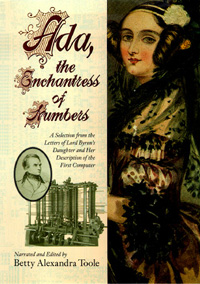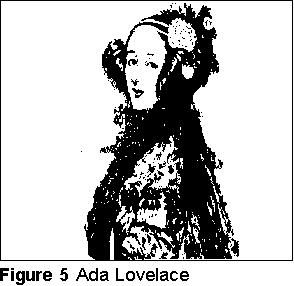
Charles Dickens to Ada: Stop haunting me
When she was thirty-three, Ada spent some time in
Brighton with Charles Dickens. Soon afterwards (18 February 1849), he wrote her that
strange things were happening at his hotel. He wondered whether Ada was
"haunting" him, and if so: "I hope you won't do so."
Three years later, Dickens visited Ada at her deathbed. He was one of the last non-family
members, other than her physicians, to see her alive.

Charles Babbage on Ada's notes:
"If you are as fastidious about the acts of your friendship as you are about those of
your pen, I much fear I shall equally lose your friendship and your Notes. I am very
reluctant to return your admirable & philosophic 'Note A.' Pray do not alter it . . .
All this was impossible for you to know by intuition and the more I read your notes the
more surprised I am at them and regret not having earlier explored so rich a vein of the
noblest metal."
Ada Byron King,
Countess of Lovelace
, England; December 10, 1815 - 1852
Contributed by Dr. Betty Toole 
Ada Byron, Lady Lovelace, was one of the most picturesque characters in computer history. August Ada Byron was born December 10, 1815 the daughter of the illustrious poet, Lord Byron. Five weeks after Ada was born Lady Byron asked for a separation from Lord Byron, and was awarded sole custody of Ada who she brought up to be a mathematician and scientist. Lady Byron was terrified that Ada might end up being a poet like her father. Despite Lady Byron's programming Ada did not sublimate her poetical inclinations. She hoped to be "an analyst and a metaphysician". In her 30's she wrote her mother, if you can't give me poetry, can't you give me "poetical science?" Her understanding of mathematics was laced with imagination, and described in metaphors.
At the age of 17 Ada was introduced to Mary Somerville, a remarkable woman who translated LaPlace's works into English, and whose texts were used at Cambridge. Though Mrs. Somerville encouraged Ada in her mathematical studies, she also attempted to put mathematics and technology into an appropriate human context. It was at a dinner party at Mrs. Somerville's that Ada heard in November, 1834, Babbage's ideas for a new calculating engine, the Analytical Engine. He conjectured: what if a calculating engine could not only foresee but could act on that foresight. Ada was touched by the "universality of his ideas". Hardly anyone else was.
Babbage worked on plans for this new engine and reported on the developments at a seminar in Turin, Italy in the autumn of 1841. An Italian, Menabrea, wrote a summary of what Babbage described and published an article in French about the development. Ada, in 1843, married to the Earl of Lovelace and the mother of three children under the age of eight, translated Menabrea's article. When she showed Babbage her translation he suggested that she add her own notes, which turned out to be three times the length of the original article. Letters between Babbage and Ada flew back and forth filled with fact and fantasy. In her article, published in 1843, Lady Lovelace's prescient comments included her predictions that such a machine might be used to compose complex music, to produce graphics, and would be used for both practical and scientific use. She was correct.
When inspired Ada could be very focused and a mathematical taskmaster. Ada suggested to Babbage writing a plan for how the engine might calculate Bernoulli numbers. This plan, is now regarded as the first "computer program." A software language developed by the U.S. Department of Defense was named "Ada" in her honor in 1979.
After she wrote the description of Babbage's Analytical Engine her life was plagued with illnesses, and her social life, in addition to Charles Babbage, included Sir David Brewster (the originator of the kaleidoscope), Charles Wheatstone, Charles Dickens and Michael Faraday. Her interests ranged from music to horses to calculating machines. She has been used as a character in Gibson and Sterling's the Difference Engine, shown writing letters to Babbage in the series " The Machine that Changed the World" and I have gathered her letters and writings in "Ada, The Enchantress of Numbers: A Selection from the Letters of Lord Byron's Daughter and Her Description of the First Computer Though her life was short (like her father, she died at 36), Ada anticipated by more than a century most of what we think is brand-new computing.
Timeline
| Year | |
| 1641 | Blaise Pascal develops one of the first calculating machines |
| 1784 | Augusta Mary Byron (Lord Byron's half sister) is born |
| 1788 | Lord Byron (Ada's father) is born |
| 1791 | Charles Babbage (Ada's closest friend) is born |
| 1792 | Anne Isabella (Annabella) Milbanke (Ada's mother) is born |
| 1793 | Start of the Napoleonic Wars |
| 1804 | J. M. Jacquard invents apparatus to automate looms |
| 1805 | William King (Ada's husband) is born |
| 1811 | The Luddites fight industrialization |
| 1812 | Lord Byron's maiden speech before Parliament Lord Byron's first major poetical work, Childe Harold, is published |
| 1815 | Lord Byron and Annabella Milbanke wed (January 2) Augusta Ada Byron is born in London (December 10) Battle of Waterloo and the end of the Napoleonic Wars Steamers on the Thames |
| 1816 | Lord and Lady Byron separate (January 16) Lord Byron leaves England (April 25) |
| 1822 | Lady Noel (Lady Byron's mother) dies |
| 1824 | Lord Byron dies in Greece (April 19) |
| 1828 | Ada designs a flying machine |
| 1829 | Ada gets the measles and becomes an invalid |
| 1832 | Parliament passes Reform Bill, which expanded political power |
| 1833 | Ada slowly recovers and is presented at court Ada meets Charles Babbage and his Difference Engine |
| 1834 | Babbage conceptualizes the Analytical Engine |
| 1835 | Ada weds William King (July 8) |
| 1836 | Ada's first child, Byron, is born (May 12) |
| 1837 | Ada's second child, Anne Isabella (Annabella), is born (September 22) Victoria crowned - The Victorian Era begins |
| 1838 | William and Ada become Earl and Countess of Lovelace (June 30) |
| 1839 | Ada's third child, Ralph Gordon, is born (July 2) |
| 1840 | Lord Lovelace becomes Lord Lieutenant of Surrey Babbage goes to Italy to discuss the Analytical Engine Ada begins studying mathematics with De Morgan |
| 1841 | Lady Byron reveals Ada's "Most Strange and Dreadful History" |
| 1842 | Ada returns after a nine-month absence to her mathematical studies L. F. Menabrea's description of the Analytical Engine is published in Switzerland (October) |
| 1843 | Ada's translation and Notes are published (August) |
| 1844 | Ada visits the Crosse household in late November |
| 1850 | Ada visits her father's ancestral home, Newstead Abbey |
| 1851 | The Great Exhibition, Queen Victoria's ball, and Derby Day |
| 1852 | Ada dies (November 27) |
| 1860 | Lady Byron dies (May 16) |
| 1862 | Byron, now the Viscount Ockham, dies |
| 1871 | Charles Babbage dies (October 18) |
| 1890 | Hollerith of the United States uses the punch card for sorting and tabulating information for the United States Census |
| 1893 | Lord Lovelace dies (December 29) |
| 1931 | Vannevar Bush of MIT builds the first "modern large analog" computer |
| 1946 | ENIAC - First digital computer built |
| 1974 | Proposal by military for a common high-order computer language |
| 1975 | First iteration of the language called Strawman, second iteration called Woodenman |
| 1978 | A winning language selected after extensive review |
| 1980 | Language named "Ada" in her honor |
| 1984 | "Ada" becomes a trademark of the United States Department of Defense |
For more information on Ada Byron, refer to Ada, The Enchantress of Numbers, written by Betty Alexandra Toole Ed.D. and published by Strawberry Press. Ada can be purchased through Science News Books on the East Coast at 1-800-468-544-4565, on the West Coast at Opamp 1-800-468-4322 or from Critical Connection P.O. Box 452 Sausalito,CA94966. There are a few copies left at Borders. For more information about the book or poster email adatoole@well.sf.ca.us or fax 415-388-2328.